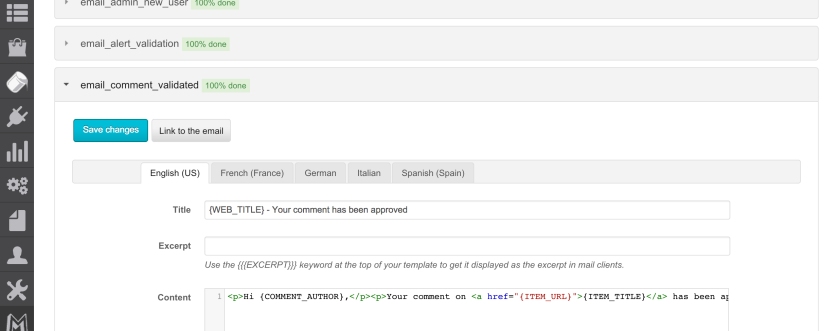This is the documentation page for Madhouse EmailMagick, an Osclass plugin to properly deal with the many emails that you need to design and translate. This document is meant to be a quickstart and should be enough to get you started.
1- Install
Just follow our tutorial on how to install a plugin on Osclass.
Now that the plugin is installed, you should have a link to EmailMagick under the Madhouse menu in your administration menu.
Read this! Madhouse EmailMagick updates all your emails at once. If you already designed your emails, backup your database before running the plugin for the first time, not to loose the content of your current emails.
2- How does it work ?
The concept at the base of EmailMagick is that design and content is separated.
3- Designing emails
First, you create a template (HTML email template including special keywords to tell EmailMagick what to do).
3.1- HTML Template
The HTML template defines the way your emails will look. It is a simple HTML email template as you would write for a newsletter but differs from it in one thing : keywords.
By default, you have a very minimal one but we’re giving you some tips in our post about creating an email template for Osclass.
{{{EXCERPT}}}<br />
{{{CONTENT}}}<br />
{{{FOOTER}}}<br />
Those special keywords are needed by EmailMagick to work. To make them work, you have to include them between three brackets. Ex. {{{CONTENT}}}.
| Keyword | Description |
|---|---|
| CONTENT | This will be replaced by the content of your email, what Osclass call the description of your email. – @see TODO |
| EXCERPT | This is the summary of your email. It is generally put at the very top of your email to serve as the excerpt in mail client. – @see TODO |
| FOOTER | The content of the footer (shared by all emails). – @see Footer |
3.2- Footer
This field gives you a way to define some content (generally located at the bottom of your emails). It can contain HTML or some links or copyrights or catchline that all your emails will share.
As you can see, you can get it translated in every enabled languages.
4- Write & Translate
Then, you have a list of all your emails that you can edit in one place without having to reload the page or open tabs.
Just click on one of them to show the form and edit its content.
| Field | Description |
|---|---|
| Title | This is simply the title of the email, nothing more. |
| Excerpt | This is the summary of your email (will replace {{{EXCERPT}}} in the template). |
| Content | The content of the email (will replace {{{CONTENT}}} in the template). |
Once, it’s done, just move up to the next & so on…
5- Time to submit
Finally, when saving changes, EmailMagick builds each email (in every languages defined) by combining the template with the content you wrote. It will update all your emails at once : the real ones, that are stored in oc_t_pages table and gets sent by Osclass.
However, if a language is empty in EmailMagick or if the language is not enabled, it will not update the emails related to this language.
Note that the template and content of your emails are stored by EmailMagick for further use !

